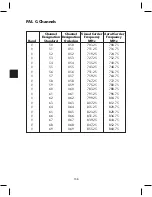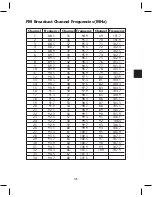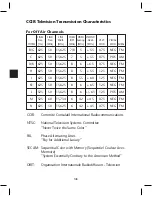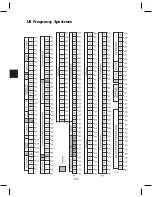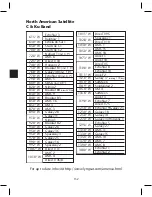
142
PAL I Channels
HRC
Channel
Designation
Standard
36
37
38
39
40
41
42
43
44
45
46
47
48
49
50
51
52
53
54
55
56
57
58
59
60
61
62
63
64
65
66
67
68
Channel
Designation
Ordering
36
37
38
39
40
41
42
43
44
45
46
47
48
49
50
51
52
53
54
55
56
57
58
59
60
61
62
63
64
65
66
67
68
Visual Carrier
Frequency
(MHz)
336.00
344.00
352.00
360.00
368.00
376.00
384.00
392.00
400.00
408.00
416.00
424.00
432.00
440.00
448.00
456.00
464.00
472.00
480.00
488.00
596.00
504.00
512.00
520.00
528.00
536.00
544.00
552.00
560.00
568.00
576.00
584.00
592.00
Aural Carrier
Frequency
(MHz)
342.00
350.00
358.00
366.00
374.00
382.00
390.00
398.00
406.00
414.00
422.00
430.00
438.00
446.00
454.00
462.00
470.00
478.00
486.00
494.00
502.00
510.00
518.00
526.00
534.00
542.00
550.00
558.00
566.00
574.00
582.00
590.00
598.00
Summary of Contents for AMM-806
Page 86: ...79 TVCB PC Installation ...
Page 93: ...86 SMI Installation Torque Patterns 1 Start Here 2 3 4 5 6 1 Start Here 2 3 4 4 PORT 8 PORT ...
Page 125: ...118 Fiber Optics Fiber Loss vs Path Length Single Mode 1550 nm ...
Page 156: ...149 Cable TV Channel Format NTSC NTSC Composite Video Waveform ...
Page 157: ...150 US Frequency Spectrum ...
Page 158: ...151 FCC Aeronautical Band Frequencies Used for Communication and Navigation ...
Page 175: ...168 Common CATV Symbols ...
Page 176: ...169 Common CATV Symbols ...
Page 177: ...170 Digital L Band Distribution Symbols ...
Page 178: ...171 Digital L Band Distribution Symbols ...
Page 183: ...176 Typical Cable Attenuation Chart in dB 100 Feet 68 F 20 C ...
Page 187: ...180 Echo Rating Graph ...
Page 188: ...181 Signal to Interference Limits Non Coherent Carriers ...
Page 190: ...183 Heterodyne Modulator Analog ...
Page 191: ...184 Heterodyne Processor Analog ...
Page 213: ...206 Multiplexers ...
Page 285: ...Rev 8 0 ...









